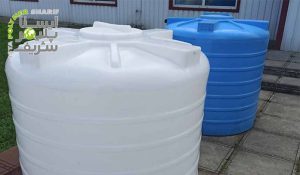Today, many factories and residential areas use tanks for storing fluids and drinking water in various volumes. These tanks preserve the liquids in standard conditions, ensuring their safety while meeting consumers’ needs. Sometimes, depending on the situation, these tanks need to be buried underground, which requires a stronger design. Therefore, tank manufacturing companies have introduced a product known as buried or underground tanks. Join us in this article to fully understand this type of tank and its features.
Types of Buried Tanks
Underground tanks are classified into different groups based on their material and shapes, as listed below:
- Concrete Buried Tanks
- Modular Polyethylene Buried Tanks
- Double-Walled Polyethylene Buried Tanks
- Corrugated Polyethylene Tanks
- Vertical and Horizontal Tanks
- Conical Tanks
- Double and Triple Layer Tanks
The material of the tank significantly impacts its characteristics, determining its resistance and the type of materials it can store. The shape of the tank also allows you to choose one with better efficiency based on environmental conditions and your needs. Stay with us to identify the features of each type and choose the ideal tank based on your requirements.
Features of Polyethylene Buried Tanks
Polyethylene tanks, at first glance, must be resistant to soil pressure to avoid damage when buried. These tanks, with their special design, can be buried up to 12 meters and are easy to install due to their lightweight. Polyethylene buried tanks can also be modular or multi-piece, with features such as resistance to acids and bases and food-grade raw materials, making them a suitable alternative to steel tanks. Polyethylene can store various acids and bases, and its non-reactivity with chemicals makes it suitable for storing a wide range of fluids. These tanks can be used as water storage tanks, septic tanks, and wastewater treatment system tanks, buried underground to assist in fluid storage and wastewater treatment. They are designed to allow relocation, so you don’t have to worry about moving and changing their location. Simply empty the tank and its surroundings, and relocate it as needed.
Modular Polyethylene Buried Tanks
These polyethylene tanks are made up of numerous panels that can be adjusted to change the tank’s capacity. Unlike regular tanks, which cannot increase in capacity once built, modular tanks can increase in capacity by adding panels. Sometimes, installing buried tanks requires passing through narrow spaces. In such cases, using modular buried tanks with thin panels allows you to pass through any space. If the tank gets damaged, only the affected panel needs repair, which can be done quickly.
Advantages of Polyethylene Buried Tanks
Polyethylene buried tanks are made from two types of heavy polyethylene: HDPE100 and HDPE80, known as corrugated and double-walled, respectively. Each type offers various benefits, which are outlined below:
- Reinforced and robust body
- Possibility of multiple installations
- Easy relocation and installation
- Different sized manholes for easy access to all tank areas
- Ability to increase volume and replace modules
- No need for a pump to deliver water or wastewater to the tank
- No design limitations for inlets, outlets, etc.
- Capability to build the tank based on installation conditions such as depth, density, soil type, etc.
These tanks are designed to function like regular tanks without posing any risks to the stored liquid. Typically, a pump is used to extract the materials from the buried tank, with its power determined by the burial depth and flow rate.
Comparison of Polyethylene and Concrete Tanks
Before the production of polyethylene tanks, concrete tanks were widely used for underground fluid storage due to their high resistance to soil pressure and density. However, with the advent of double-walled polyethylene tanks, the use of concrete tanks has declined, and these plastic tanks have taken their place. Buried tanks must have a capacity that matches the need to stay underground for a sufficient duration. Polyethylene tanks are produced in extensive capacities and more quickly than concrete tanks, making them more cost-effective. Additionally, polyethylene buried tanks have a ready system, speeding up the manufacturing process. Both concrete and polyethylene tanks can be installed underground, but concrete tanks often suffer from leakage and incomplete sealing and cannot be reinstalled. In contrast, polyethylene tanks can be relocated and reinstalled. Polyethylene tanks, using high-quality and UV-resistant materials, offer greater durability under various conditions, whereas concrete tanks can crack over time. Moreover, the maintenance cost of concrete tanks is significantly higher than polyethylene tanks, considering the repair costs.
Summary
Buried tanks come in various materials and shapes, which we have examined in this article. One of the most widely used models is the polyethylene buried tank, available in various types. Polyethylene, with its resistance to acids and bases, allows you to store a wide range of fluids. The lightweight, high resistance, and reinstallation capability of this tank make it a suitable alternative to other tanks. Therefore, after thoroughly reviewing your installation site and fluid storage needs, consult with sales advisors from different companies to identify the best product.






